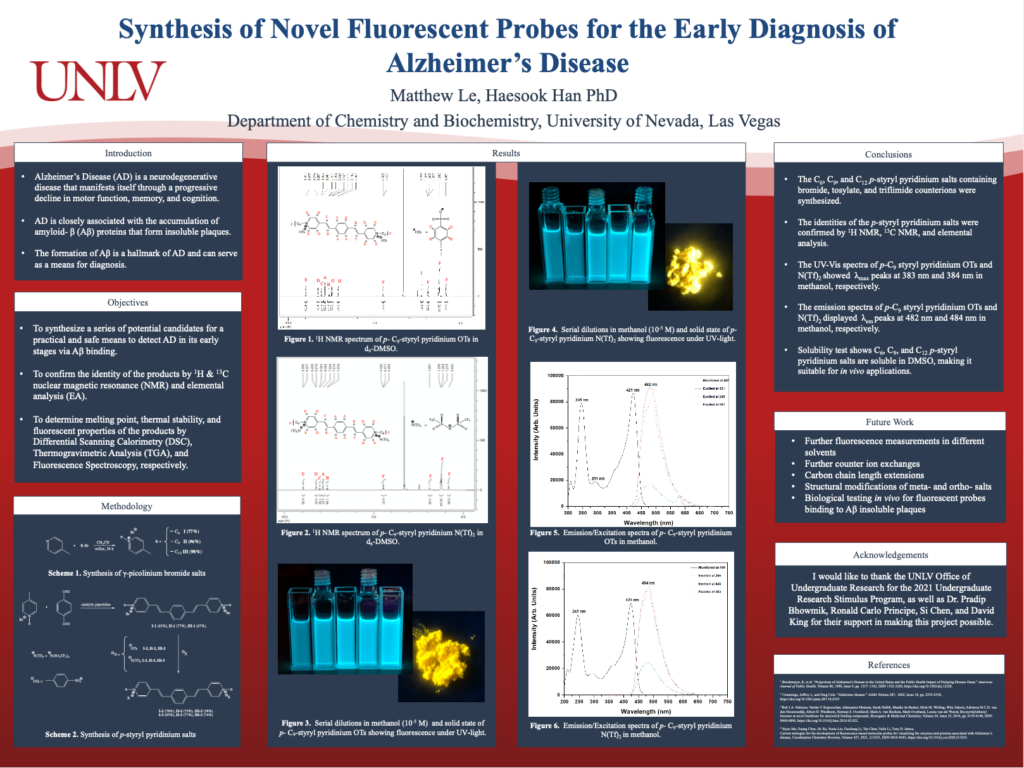HNSE-P6-6. Synthesis of Novel Fluorescent Probes for the Early Diagnosis of Alzheimer’s Disease
Matthew Le1
Pradip Bhowmik, Ph.D.2
David King2
Faculty Mentor: Haesook Han, Ph.D.2
1College of Sciences, Department of Life Sciences
2College of Sciences, Department of Chemistry and Biochemistry
ABSTRACT
Alzheimer’s Disease (AD) is a pervasive form of dementia that accounts for 60% to 70% of progressive cognitive impairment within the elderly population. This neurodegenerative disease manifests itself through a progressive decline in motor function, memory, and cognition. AD is closely associated with the accumulation of amyloid- β (Aβ) proteins that form insoluble plaques. The formation of Aβ is a hallmark of AD and can serve as a means for diagnosis. Our objective was to synthesize potential molecular probes for a practical and safe means to detecting AD in its early stages. We synthesized the target fluorescent probes by Knoevenagel condensation to yield p-styryl pyridinium salts of different carbon chain lengths by reacting terephthalaldehyde and γ-picolinium bromide salts. Additionally, counterion exchanges of bromide to tosylate and triflimide were subsequently carried out for each salt in the series. The synthesized probes were characterized by proton (1H) and carbon 13 (13C) nuclear magnetic resonance spectra analysis, elemental analysis, differential scanning calorimetry, thermogravimetric analysis, and fluorescence spectroscopy. Their fluorescent properties suggest that the synthesized probes are viable candidates to be tested in vivo for their binding to insoluble plaques. These findings will serve as a foundation for research into further carbon chain extensions, counter ion exchanges, and structural modifications of fluorescent probes.
Speakers
-
David King | College of Sciences
-
Dr. Haesook Han | College of Sciences
-
Dr. Pradip K. Bhowmik | College of Sciences
-
Matthew Le | College of Sciences



Hello Matthew Le,
Your presentation on the Early Diagnosis of the Alzheimer’s Disease with fluorescent probes and amyloid Beta proteins was very informative and interesting. The only criticism I have is the format of the video. The poster in the video is small and a bit hard to see. Maybe, at the beginning, introducing yourself and the subject on video would help give the poster more screen estate. That way we can follow along with your pointer. Overall, I thought science behind a way to diagnose Alzheimer’s at an early state was pretty cool. Great Job!!!
Matthew,
I enjoyed listening to your presentation. For someone who had no previous knowledge of the processes of diagnosing patients with AD, your presentation was easy to follow and understand. The use of visuals of the chemical compounds helped to retain and understand the information.